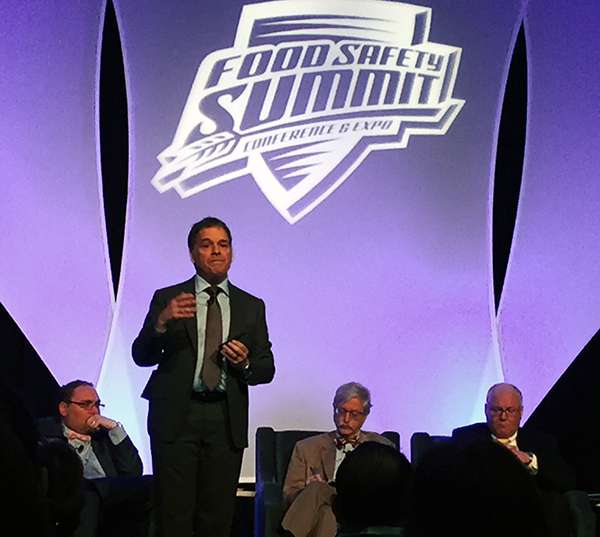For a long time, companies could effectively run food safety programs using only manual methods of quality management, such as pen, paper, spreadsheets and emails. Those practices have served the food industry well, but it was only a matter of time before food safety and quality management systems became mostly an exercise of technology.
Even before COVID-19, industry trends and government requirements (e.g., FSMA, the FDA’s New Era of Smarter Food Safety) were setting roadmaps for modernizing food safety and quality management with technology. Additionally, the food industry is thirsty for better performance, more insights and data-based decisions—all things that need more sophistication than manual systems.
As we continue through the throes of the pandemic, it’s abundantly clear that the tech-based future we were planning for five to ten years in the future is happening now. It’s both unavoidable and imperative for the food industry to quickly adapt to the new landscape in front of us. It’s as the CEO of Airbnb, Brain Chesky, recently said: Because of the pandemic, he had to make “10 years’ worth of decisions in 10 weeks.”
From my viewpoint, I see at least seven additional trends that are also expediting modernization in our industry.
1. A shift toward proactive mindset versus reactive habits. Always reacting to what’s happening around you is precarious and makes it difficult to mitigate risks, for you as well as your location employees. The benefits of being more strategic and prepared for different scenarios can shore up your foundation, making you more ready for crises at the corporate and location level. Gathering, combining and analyzing data with technology gives you more insights, so you can make data-based decisions quickly and with more confidence.
 |
Kari Hensien and Matt Regusci of Rizepoint will be participating in a Q&A with Dr. Darin Detwiler, Assistant Dean, Northeastern University College of Professional Studies, during the final episode of the 2020 Food Safety Consortium Virtual Conference Series on December 17. |
2. Empowerment of employees to act as chief quality officers. This comes down to the difference between training employees versus coaching them. Giving employees rules (training) is one thing but showing them the reason why a rule exists (coaching) is another. In other words, when you add more coaching, you’re empowering employees to identify and act on the right thing to do for themselves—which is chief quality officer behavior.
It is important to reassure employees during coaching that honest assessments will result in managers’ support rather than punishment when things go wrong. When all employees proactively watch for quality and compliance issues and get the right support when bringing up these issues, you’re more likely to catch (and fix) small issues before they become huge liabilities.
3. An increase in virtual audits and self-assessments. I don’t believe the corporate audit will ever go away, but our customer data is showing a marked increase in location self-assessments and virtual audits before the pandemic, and even more since March.
Right now, these audit types are a necessary stopgap while the health and safety of auditors is in question. However, I’m also confident that virtual audits and self-assessments will continue to rise. The reason? These audits can start giving you a continuous view of food safety initiatives instead of a single point-in-time view.
Even though corporate audits are still part of best practices, shorter self-assessments and other evaluations can help you glean more data and gain more visibility on a continual basis, especially if you use technology to store and analyze your data in one place.
4. Continuous quality monitoring is overtaking point-in-time audits. Let’s expand on this trend. Manual processes may provide some valuable data, but it’s impossible to build real-time, integrated views into your business with only a yearly audit. It merely shows you a single (but important) point in time rather than what’s going on at each location right now. Additionally, since everyone is watching every employee at all store locations due to COVID-19, it is critical to have a checks and balances system to continually correct small issues and to find coaching opportunities.
Again, it’s virtually impossible to do this with paper checklists and email blasts because the daily-gathered data can easily be misfiled, deleted or otherwise lost. Many quality management software systems are built to integrate, store and analyze your data in a continuous manner.
5. Consolidation of multiple programs into single software solutions. As you think about updating your programs and systems from manual processes, it is important to remember that you don’t need a different solution for every activity. For example, you don’t necessarily have to invest in an auditing app, an analytics platform, and a document storage solution (and still probably manage many spreadsheets). There are many quality management software companies that have solutions built to combine and streamline all the activities you need to manage food safety or other quality management programs.
6. Innovations to share costs with suppliers. Budgets have not likely increased due to COVID-19, so investing in modernization may seem like a pipe dream. But many companies are offsetting their costs in a new way. They are requiring suppliers to use a specific software system to submit their qualifying documents, and then these companies are charging reasonable fees for suppliers’ use of the software.
Additionally, there more benefits to managing suppliers within your quality management system. First, it can streamline document collection and storage, and second, it gives you an opportunity to communicate and collaborate with your suppliers on a deeper level.
7. Standards bodies are accelerating plans to update requirements. As seen with GLOBAL.G.A.P. this year, some standards bodies are updating their digital submission requirements to streamline certification submissions as well as start building up sharable industry data so certification bodies can do their jobs better. Additionally, GLOBALG.A.P has already partnered with existing quality management software companies to make the integration and submission process even easier, and other standards bodies are sure to follow.
It’s clear to me that these trends are of a long-term nature, and each one requires updating manual food safety and quality programs to quality management system software solutions. Acting on these trends in any number will require modernization and digital transformation to have a lasting impact on your programs and your business. The mode of “just keeping the doors open” is not sustainable and will not last forever, so now is the time to start building a better food safety future.












